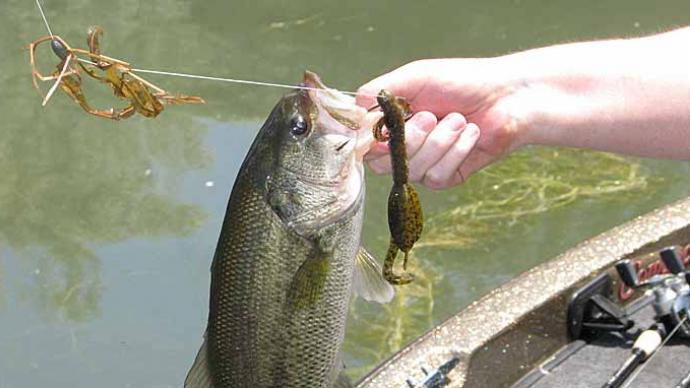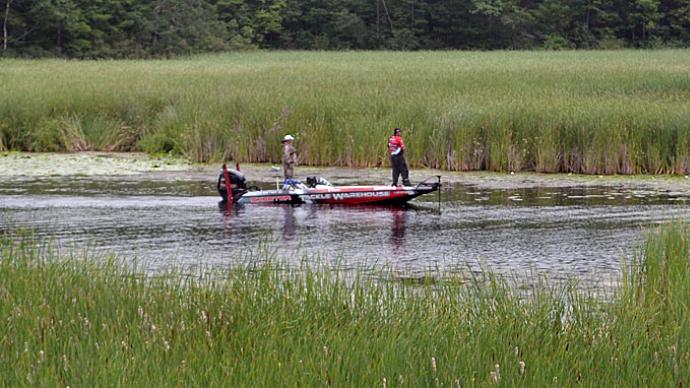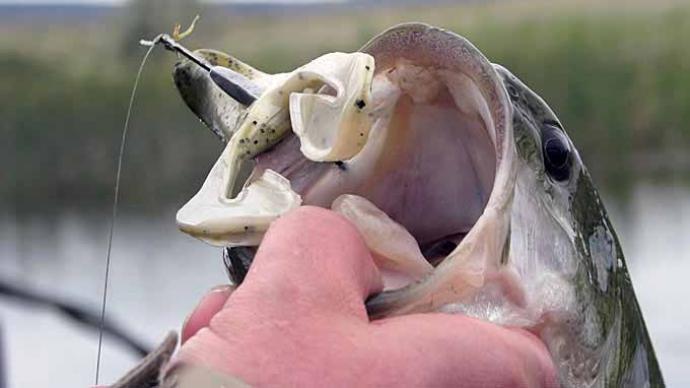| Scale down for smallmouths? Not a chance |
|
New Hampshire pro Rick Lillegard scoffs at the notion that in order to catch quality smallmouths from clear lakes, you have to use smaller baits, lighter line and a finesse approach. He does just the opposite. "I like 3/4-ounce spinner baits with chartreuse or white blades tied on 20-pound green Silver Thread line," Lillegard said. "The line size doesn't matter when you are working a bait really fast, which is how we use those big spinner baits." Lillegard also likes full-size Zara Spooks (he uses them all day, even when the sun is high and bright) and 6- or 8-inch plastic lizards on a Carolina rig. Smallmouths, he says, are just like largemouths in the sense that larger baits typically catch larger bass. Of course, that may just be another myth. |
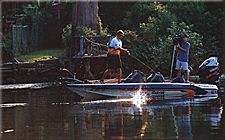
Bernie Schultz hears it all the time. And in a way, he's glad that most bass anglers follow those age-old rules that have dictated bass fishing for so long. You know - the ones that tell you to put the topwaters away when the sun hits the water. Or that bass abandon the shallows and bury themselves in 30 feet of water in the middle of summer. What about the one that tells you to hang up the gear until winter relaxes her grip on your favorite lake and the water temperature climbs into the 50s?
Myths. All of them.
"It makes my job easier when all the other anglers in a tournament are doing what they think they ought to be doing," said Schultz, a resident of Gainesville, Fla. "I don't necessarily follow the rules, and I've had some very good tournaments fishing in places that nobody else thinks hold any bass."
As a group, bass anglers follow those long-standing myths like lemmings following the herd off a cliff. But rules were made to be broken, and anglers who can break away from the crowd and fish with an open mind can score some tremendous fish. Forget about what the experts say. Bass behave in ways that even the best anglers will never understand, and sometimes that means they go places and do things that few anglers expect.
Shallow Summer Bass
One of the most common myths says that to catch bass in the summer heat, you have to back off and dredge the bottom in 25 feet or more of water. Nothing could be farther from the truth, says Schultz. He admits that many bass do cower in the depths when the water sizzles but plenty are catchable for those who prefer to cast to visible targets in shallow water. Schultz is that type of angler.
"It doesn't matter where you are," Schultz said. "I've caught bass in shallow water in hot weather in the North and South, on natural lakes, reservoirs, rivers - all over the place. The truth is, plenty of bass stay shallow in the middle of the hottest, brightest day. I've caught some tremendous fish from 2 feet of water when the surface temperature was 90 degrees. They really become predictable after that initial period of high activity in the morning."
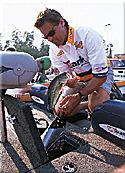
Once the early morning feeding turns off in shallow water, Schultz does what few anglers do - he stays where he is. But unlike less experienced anglers, he switches gears and targets very specific types of cover with a handful of lures.
"I go to high-percentage areas - wood and grass," he said. "Shallow bass use those types of cover because they provide shade, although they don't necessarily need a canopy. Areas with some sort of shade just seem to produce better."
Schultz recalls a tournament held on Minnesota's Lake Minnetonka, where he stayed on a shallow pattern while other anglers fished deep. The bass had finished spawning, but contrary to popular belief, many postspawn females were still shallow. He found them in as little as a foot of water under mats of reeds where the bank had washed out under the plants to form a sort of undercut right against the shore. He recalls that the fish were somewhat lethargic, so he threw a tube and worked it slowly along the bottom to tempt those finicky bass.
That slow retrieve, says Schultz, is the key to catching shallow bass during the heat of a summer day. He typically uses soft plastic lures with little or no action - straight-tail worms, tubes, and craws - and works them at a glacier's pace along the bottom adjacent to wood or grass cover.
"It's also really important to make accurate casts," he said. "The fish are going to be very spooky, so it will make a huge difference if you make quiet presentations and keep boat noise to a minimum. I'll use a push pole instead of the trolling motor to move through shallow grass."
Topwater Time
Too bright, too hot, too anything for a topwater? Think again. Some of the best surface-lure action can occur when most bass anglers least expect it - right in the middle of a warm, sunny day. Virginia Beach, Va., pro Rick Morris lets the fish tell him when it's time to stow the Pop-R and reach for some sort of sub-surface bait.
"You have to realize that like any type of lure or tactic, topwaters aren't going to work all day long every day," Morris said. "You won't catch a bass on a spinner bait all day, every day, either. However, there are certain times of the year when topwaters can produce some fantastic results all day. It doesn't matter how hot or bright the sun is. If the bass are shallow and active, they might even eat a Zara Spook or a Pop-R better than they would something else."
Two of the best times to throw a topwater, no matter what time of day, are in the fall when the water starts to cool and bass move shallow, and then again right after the spawn when fish feed heavily to rebuild strength. During a tournament on Kerr Reservoir on the Virginia/North Carolina border a few years ago, Morris and his partner both fished surface lures and caught some heavy stringers of bass. Morris threw a Zara Spook, which produced fewer bites but larger bass; his partner fished a Pop-R and caught more bass.
"It was hardly what most people would call a perfect topwater day," Morris said. "It was bright, and there was only a slight breeze, but we stayed on that pattern and caught fish all day. The strikes were violent, too. I mean, the bass tried to kill our lures. We just worked our way in and out of creeks and pockets off the main creek arms, which is where the postspawn bass were cruising. You can cover much water if the topwater bite stays good through the middle of the day."

So how do you know if it's the right time to throw a topwater? You really can't tell, says Morris, until you try it.
But topwaters should never be considered a lure just for those prime conditions. Topwaters work when they work, even during the middle of a blazing hot afternoon.
Like many other bass anglers, Trussville, Ala., pro Randy Howell prefers fishing shallow water. So when he and a friend were practicing for an FLW Tour event on Alabama's Lake Wheeler with nothing to show for their efforts, they decided to move close to the shore and beat the bank. Never mind that the water was 37 degrees and light snow was falling. Howell decided to give it a try.
"We ended up catching two bass, one 7 1/2 pounds and another 7-pounder from stumps in 2 feet of water," Howell said. "We were pitching jigs to these visible stumps, and the bass hit the lures just like when the water is warmer. They really smashed them."
It wasn't Howell's first experience with shallow winter bass. While living on Virginia's Lake Gaston, he pitched jigs to docks in December and caught some tremendous fish. Most other anglers who targeted bass that time of year worked deep water. In fact, he says some of his largest bass have come from skinny water during the coldest months, adding that anglers who want to target quality largemouths would be well served to follow his lead.
During another FLW Tour event, this one on South Carolina's Lake Murray, he caught good numbers of big fish from shallow docks with brush under them when water temperatures hovered in the high 40s. And like that day on Lake Wheeler, a steady snow fell during part of the tournament. Howell pitched Lunker Lure Rattleback jigs tipped with a Hog Caller trailer to docks with brush on them. They were the same docks that produced plenty of bites during practice when the water was warmer and the weather was more suited to shallow water fishing. The bass simply stayed put, although plenty of other anglers backed off and worked deeper water during the tournament.
"I think the key for finding shallow bass in the winter is to have deeper water nearby," Howell said. "They won't be shallow all the time, but if you aren't catching them deep, move shallow. That's what happened with those two big ones we caught on Wheeler. There was a 10- to 12-foot deep ditch right next to the area with the stumps, and I think the bass moved up to feed."
Equally important, he adds, is to fish slowly and deliberately. Howell says although many of his shallow-water strikes have been quite violent, the fish seem to want a slower-moving bait. Jigs are ideal, although some anglers score on suspending jerkbaits even when the water hovers around the 40-degree mark.
There are no set rules for finding shallow bass in the winter, or in the summer, for that matter. Anglers who can break away from the age-old myths that run rampant through the bass-fishing community can have some tremendous days. Try something new, and you might be pleasantly surprised.
Content provided by Bass Fishing Magazine, the official publication of FLW Outdoors


